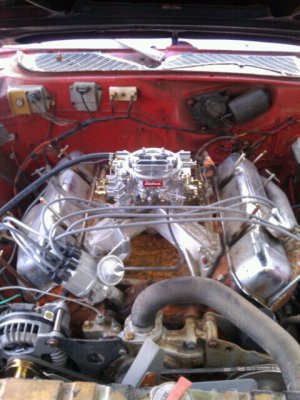Go to Rad Shack and get two--three bags of their clip leads. One bag with the bigger clips, another of the smaller, and if you do not have a multimeter BUY one.
Get the engine running and warm, and kick the RPM up to simulate "medium cruise" Measure charging voltage right at the battery. It should be around 13.8--14.2, and in no case below 13.5 nor above 14.5
IF NOT substitute another battery, charge that one and test again, and if still low, repair the charging system
If this is OK, do the following:
(Easier with two people)
Stab the meter DIRECTLY into the tops of the battery posts, NOT the battery clamps, but the actual battery posts
Have someone crank the engine for at least 5 seconds if it will crank that long and then take a reading WHILE it is cranking. You should have AT LEAST 10.5 bolts, and the higher the better.
IF NOT make sure the battery is charged, or do so, then take the battery to someone who has a battery LOAD TESTER and have the battery tested
THIS is what a load tester looks like. If the teen-age "parts man" comes out with something in one hand, go somewhere else
If the battery load test is OK, time for more tests. You may have to perform these with the engine warm if nothing shows up cold
Clean clean CLEAN the battery cable clamps
If the battery is charged, load tests OK, and cleaning the battery clamps don't help, it's either:
bad cables
bad connections
or the starter
Clip your meter using clip leads onto the big stud on the starter. Do not hook to the cable terminal, but the stud itself.
Stab the other meter lead, set on low DC volts, into the positive cable clamp on the battery. You are measuring voltage drop through the cable.
Crank the starter using either a remote button, or with a screwdriver jumpering the start relay. Read the meter WHILE CRANKING You are hoping for a low reading here, the lower the better, and more than about .4V (4 tenths of one volt) means either the cable is bad, or the start is drawing a HELL of a lot of current
Make the same test on the NEG cable. Clip your meter to a good ground on the block, and stab the other probe into the NEG clamp on the battery. Crank the engine, read the meter, same reading as above.
If you get the SAME drop readings (or close) on both cables it is likely that the STARTER is AFU.
If one cable has say, twice the drop, IE one is .3, the other .6, then the cable with the higher reading is too small, corroded inside, or a bad connection.
IF YOU can get the car to wherever the load tester is, you can also use the load tester to measure starter current draw. You do this by what is called "matching amperage."
The way a carbon pile tester works is by using a huge adjustable resistor to pull current from the battery, just like hooking a whole truck load of light bulbs to it. So to test starter draw, you hook up the carbon pile tester, with the resistor to the left CCW. No load. You crank the engine a few seconds and watch for the battery voltage to load down under the sarter load, and NOTE the battery voltage with the starter cranking. Let's say, 10.7V just a figure.
Then you release the starter, and you crank in a load on the battery by cranking the resistor in CW until the voltmeter drops down to the SAME reading as when you were cranking, the 10.7V or whatever it read. Then you quickly read the ammeter and this LOAD reading will be the same as what the starter was drawing.
To wind this all up, there are four main areas of starter problems:
Worn out, or undercharged battery, or just too small for the engine
Bad cable connections, or internally damaged cables
Bad starter
Engine dragging, IE spun bearings, etc or other abnormal causes of engine / transmission friction.

















